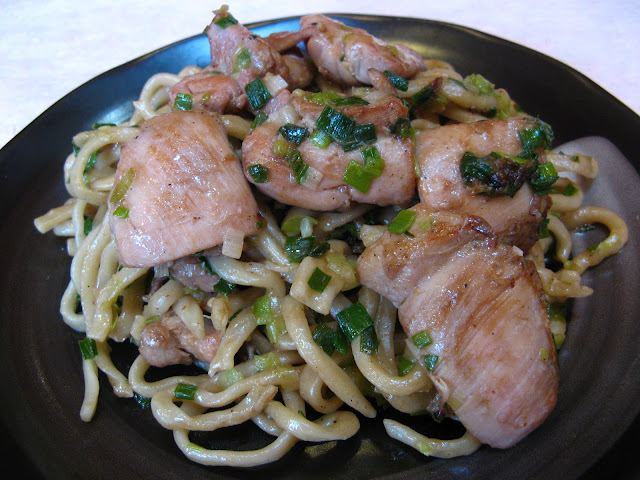This recipe was updated on 12 Jun 2015. Some instructions
and ingredient quantities were changed, and metric measurements added.
I go to the local Farmer’s Market every Sunday. My favorite
stall at the market has been selling huge bundles of green onions and I thought
that I would make a noodle dish based on this ingredient. The simpler and one
of the first noodle dishes I learned how to cook uses Lee Kum Kee brand premium
oyster sauce as the basis for the sauce. So I added a good amount (i.e. a lot!)
of chopped green onions to make this dish using Shanghai noodles, which are
thicker than the normal chow mein noodles. Shanghai noodles are available in
the refrigerator section at your Asian market. Regular chow mein noodles can be
substituted if Shanghai noodles are not available. Surprisingly the amount of
green onions add a great natural sweetness to the dish.
Enjoy!
Ingredients
|
¾ lb.
|
375 g.
|
Chicken thigh
or breast meat (雞肉, gai1 juk6), cut
into 1-inch (2.5 cm.) pieces
|
|
1 tsp.
|
5 ml.
|
Baking soda (蘇打粉, sou1 daa2 fan2)
|
|
½ in.
|
15 mm.
|
Knob of ginger
(薑, goeng1), crushed in a garlic
press
|
|
2 cloves
|
2 cloves
|
Garlic (蒜, syun3), crushed in a garlic press
|
|
1 Tbs.
|
15 ml.
|
Corn starch (粟粉, suk1 fan2)
|
|
2 Tbs.
|
30 ml.
|
Soy sauce (豉油, si6 jau4)
|
|
1 Tbs.
|
15 ml.
|
Hoisin sauce (海鮮醬, hoi2 sin1 zoeng3)
|
|
2 Tbs.
|
30 ml.
|
Shaoxing rice
wine (紹興酒, siu6 hing1 zau2)
or dry sherry
|
|
½ tsp.
|
2.5 ml.
|
Ground white
pepper (白胡椒, baak6 wu4 ziu1)
|
|
1 tsp.
|
5 ml.
|
Sesame oil (麻油, maa4 jau4)
|
|
12-18
stalks
|
12-18
stalks
|
About ½- to ¾-lb.
green onions (葱, cung1), cut into ¼-inch (7.5
mm.) pieces
|
|
1 lb.
|
500 g.
|
One package Shanghai
noodles (上海麵, soeng6 hoi2 min6)
|
|
|
|
Oil for
cooking
|
Sauce Ingredients
|
3 Tbs.
|
45 ml.
|
Lee Kum Kee brand premium oyster sauce (蠔油, hou4 jau6)
or equivalent
|
|
1 Tbs.
|
15 ml.
|
Shaoxing rice wine (紹興酒,
siu6 hing1 zau2) or dry sherry
|
|
½ tsp.
|
2.5 ml.
|
Ground white pepper (白胡椒, baak6 wu4 ziu1)
|
|
½ Tbs.
|
7.5 ml.
|
Sesame oil (麻油, maa4
jau4)
|
Equipment
|
|
|
Garlic press
|
|
14 in.
|
35.5 cm.
|
Wok or pan
|
 |
| Lee Kum Kee Brand Premium Oyster Sauce (蠔油, hou4 jau6) |
Preparation Instructions
- Prepare the chicken thigh or breast meat by removing any skin or bones, and cut into 1-inch (2.5 cm.) pieces. Wet with water and add baking soda to the chicken, allow to tenderize for 15 minutes, and then wash the baking soda from the meat. The baking soda can be omitted but results in the tender meat experienced in restaurant dishes.
- Marinate the chicken in a covered container for at least one hour or overnight in the refrigerator with the ginger and garlic crushed in a garlic press, corn starch, soy sauce, hoisin sauce, Shaoxing rice wine or dry sherry, ground white pepper, and sesame oil. If marinating the chicken overnight, take it out of the refrigerator at least one hour before cooking.
- Wash and cut the green onions into ¼-inch (7.5 mm.) pieces.
- Prepare and mix the sauce in a small bowl: add the Lee Kum Kee brand premium oyster sauce or equivalent, Shaoxing rice wine or dry sherry, ground white pepper, and sesame oil.
Cooking Instructions
- Cook the noodles according to the instructions on the package and until the noodles are al dente. Drain the noodles and set aside. If using thawed, ready-made, or fresh noodles, “fluff” the noodles to separate them (i.e. you don’t want put a single mass of noodles into the wok).
- Heat a wok or pan over high heat before adding oil. Add the chicken pieces to the wok in a single layer on the bottom and brown the outside. You may have to cook the chicken in batches, so be sure to reheat the wok over high heat before adding more oil. Set the chicken aside in a bowl.
- Reheat the wok over high heat before adding more oil and then the noodles. The wok should be very hot before adding the oil and then the noodles. Noodles cooked in a restaurant wok (over much higher heat than that available in your kitchen) are served slightly burned, which gives the noodles an extra added flavor. To try to emulate slightly burned noodles, try to put the noodles in one layer in the hot wok and add some liquid (water, stock, or Shaoxing wine; but not too much liquid otherwise you’ll steam the noodles) to facilitate the heat transfer from the wok to the noodles, and leave the noodles alone. You want the noodles to get burned before adding more oil to the noodles and turning them over, repeating the process.
- Add the green onions and the contents of the bowl with the chicken back into the wok, and stir fry all the ingredients together. Add the sauce ingredients to the wok and stir fry the ingredients together. Put the cooked ingredients into a serving dish and serve immediately.

No comments:
Post a Comment